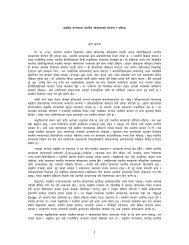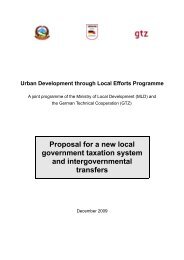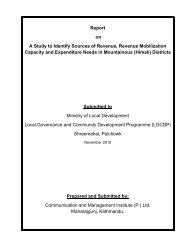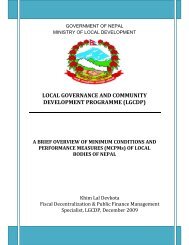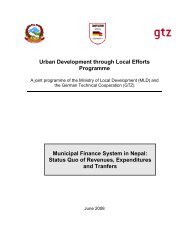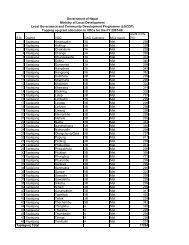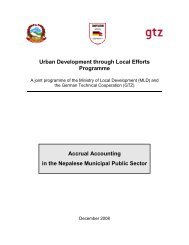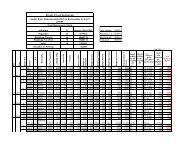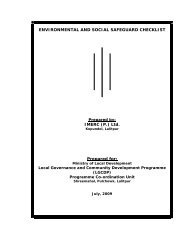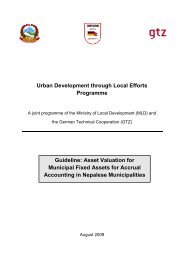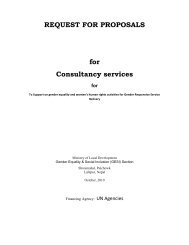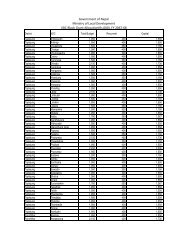LGCDP M&E Framework
LGCDP M&E Framework
LGCDP M&E Framework
You also want an ePaper? Increase the reach of your titles
YUMPU automatically turns print PDFs into web optimized ePapers that Google loves.
a) ENGAGEMENT WITH LOCAL GOVERNMENTS<br />
Engaging with local governments, together with holding them accountable, is a key component of this outcome.<br />
It refers to engagements in planning and implementation of local government activities and is based on an<br />
inclusive process. Taking part in local government is the ultimate level of active engagement.<br />
Indicators: • % of citizens that think that they are now more involved in the decisionmaking<br />
process of DDCs than one year ago<br />
• % of citizens that think that they are now more involved in the decisionmaking<br />
process of VDCs than one year ago<br />
• % of citizens that think that they are now more involved in the decisionmaking<br />
process of municipalities than one year ago<br />
Rationale: These three indicators track the level of satisfaction with being engaged in local<br />
governance. It is based on the recall method and refers to one year.<br />
Limits: • These indicators are based on subjectively perceived levels of engagement as a proxy<br />
for actual changes in engagement with local governments The data is obviously<br />
subjective and influenced by external factors. However, at a highly aggregated level<br />
and tracked over numerous years the data will be able to show trends and tendencies.<br />
Baseline: To be determined by <strong>LGCDP</strong> baseline survey in 2009<br />
Target:<br />
To be determined after the <strong>LGCDP</strong> baseline survey<br />
Means of<br />
<strong>LGCDP</strong> Sample Surveys<br />
Verification<br />
Frequency every 2 years (2009, 2011, 2013)<br />
Responsibility M&E Section of MLD<br />
Planning<br />
Indicator: % of all ward committees which hold at least one planning meeting per year<br />
Rationale: This indicator broadly reflects the level of citizen’s engagement in the planning process at<br />
local levels by tracking how many ward committees are functioning (defined as holding at<br />
least one planning meeting per year). This indicator is supplemented by the indicator<br />
below.<br />
Limits: • The % figure will initially be low due to the fact that the most of the wards<br />
committees are currently not established and/or functional.<br />
• There are 9 wards in each of the 3,915 VDCs and 9 to 35 wards in a municipality,<br />
resulting in approximately 36,000 wards.<br />
Baseline:<br />
Target:<br />
Means of<br />
Verification<br />
Frequency<br />
Responsibility<br />
currently not available; the data should be collected through two sources:<br />
• sample surveys conducted by MLD<br />
• collection of administrative data from VDCs, DDCs to MLD<br />
Sample surveys can continue to collect this data for triangulation and quality control of<br />
administrative data. An indicative target is 90%.<br />
every 2 years (2009, 2011, 2013 for sample survey) / annually (administrative data)<br />
M&E Section of MLD (for both survey and administrative data)<br />
Indicator: Total number of citizens who participate in planning meeting at ward level per<br />
year in Nepal<br />
Rationale: The overall number of participants at ward planning meetings over time is an additional,<br />
broad measure of the changing levels of participation at the grass-root level. In addition,<br />
the aggregation of data through administrative channels will be a major step constructing<br />
information gathering channels through the MLD M&E Section. This indicator complements<br />
the indicator above.<br />
Limits: • Not all wards will immediately have planning meetings in year one of <strong>LGCDP</strong>. The<br />
numbers therefore only reflect those wards where planning meetings have taken<br />
place.<br />
Baseline:<br />
see above<br />
Target:<br />
Means of<br />
Verification<br />
Frequency every 2 years (2009, 2011, 2013 for sample survey) / annually (administrative data)<br />
Responsibility M&E Section of MLD (for both survey and administrative data)<br />
8



